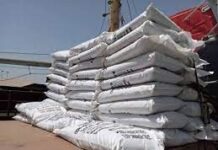This column is devoted to monitor and report on issues that relate to production, processing, preservation and marketing of agricultural produce, aimed at ensuring food security in the Gambia as well as the interventions of Government and Non-governmental Organizations in this regard.
Agriculture remains both a new and old source of national revenue and (youth) employment. Improved public awareness and discussions of the issues involved, will significantly maximize agricultural outcomes and the contribution of the sector to economic growth and job creation.
Agriculture is the mainstay of the Gambian economy, and contributes between 25 to 30 percent of the country’s GDP and employs over 70 percent of the labour force.
Agriculture accounts for about 30 percent of the country’s foreign exchange earnings, mainly from the export of the major cash crop, groundnut.
The sector is characterised by subsistence rain-fed production of food crops comprising cereals mainly coarse grains and rice, semi-commercial production of groundnuts and sesame, traditional livestock production, fishing and horticulture.
Despite being the main livelihood for the majority of Gambians, agriculture continues to be marred by low input farming systems, with the majority of small-scale farmers not using improved seeds, and fertilizer among others.
These coupled with the labour intensive and drudgery in tilling the land, limit the factors to increasing production and productivity of farming in the Gambia.
Hence farming is currently largely dependent on human and animal power, greatly hindering the timeliness of operations and improved crop husbandry.
This is a major challenge to the development of the country’s agriculture sector in having access to land preparation, weeding, harvesting and post-harvest processing machineries. Groundnut production is the main occupation of the rural population.
The development of agricultural services and the national industrial complex, evolved around groundnut production, processing and marketing.
The commercial production of the crop was facilitated by the West Africa Produce Control Board created by the British Government during the Second World War, and later the Gambia Oilseed Marketing Board (GOMB), established by Act No. 29 of 1948.
GOMB was subsequently renamed Gambia Produce Marketing Board Act of 1973, with a monopoly in groundnut processing and marketing. Since then, the groundnut industry became synonymous with the Gambian economy.
However in the early 1990’s, as a result of the Structural Adjustment Program with the IMF, the Government of the Gambia agreed to liberalize groundnut marketing in the country. Consequently, the GPMB Act of 1973 was repealed and the Board’s core assets relating to groundnut processing and marketing were consolidated to form a limited liability Company called Gambia Oilseed Processing and Marketing Company (GOPMAC). This company was later sold to Alimenta SA of Geneva in 1993 who renamed it as Gambia Groundnut Corporation (GGC).
In 1999, the Jammeh Government nationalized the Corporation but allowed it to operate without interference with its day to day operations. In its attempt to fully liberalize the groundnut industry, Government allowed GGC to only provide handling and processing services to private operators with the objective of building the capacity of these operators, to fully take over the industry.
It was during this period which saw a number of local and at times international Companies participate in groundnut marketing. Lack of financial muscle of most of these Companies resulted in huge losses to local financial institutions that provided funds for the purchase of groundnut.
The biggest negative impact was more on the producers and their cooperative produce marketing societies (CPMS) as credit purchases persisted, which at times were not honored.
This resulted in the dismantling of the Gambia Co-operative Union, the apex body of Cooperative Societies (CPMS) in the country, which served as the link between producers, buyers, processors, etc.
In the process, managerial capacity especially with changing groundnut marketing requirements in terms of quality, were lost.
With changing groundnut marketing requirements regarding quantity and quality, the CPMS were found wanting.
Read this Column to trace the problem of Groundnut Marketing in the Gambia.





















